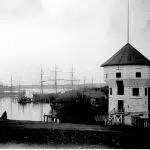
‘Train hard and fight easy:’ Nanaimo waters host marine response drills
NANAIMO — Boats and a helicopter flying around the city’s north end last week caught more than a few interested onlookers.
Multiple boats and a helicopter were seen actively engaged in a situation off Nanaimo’s Neck Point in the early afternoon of Wednesday, Dec. 14 for around an hour, a scene which looked impressive from the shore but was routine training on board.
Lt. Col. Jean Leroux, commanding officer of the search and rescue squadron 442 at CFB Comox, told NanaimoNewsNOW his team was taking advantage of a rare opportunity to simulate a response with an RCMP marine unit, with a focus on “boat hoisting”
“We come very close to the boat then we lower our search and rescue technician onto the boat. We do multiple sequences with different variations of the extraction. For example, we put a rescue basket on the boat.”


